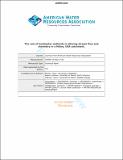| dc.contributor.author | Morley, Terry R. | |
| dc.contributor.author | Reeve, Andrew S. | |
| dc.contributor.author | Calhoun, Aram J. K. | |
| dc.date.accessioned | 2016-08-26T08:30:02Z | |
| dc.date.available | 2016-08-26T08:30:02Z | |
| dc.date.issued | 2011-03-28 | |
| dc.identifier.citation | Morley, T. R., Reeve, A. S. and Calhoun, A. J.K. (2011), The Role of Headwater Wetlands in Altering Streamflow and Chemistry in a Maine, USA Catchment1. JAWRA Journal of the American Water Resources Association, 47: 337–349. doi:10.1111/j.1752-1688.2010.00519.x | en_IE |
| dc.identifier.issn | 1752-1688 | |
| dc.identifier.uri | http://hdl.handle.net/10379/5997 | |
| dc.description.abstract | Headwater wetlands, including hillside seeps, may contribute to
downstream systems disproportionately to their relatively small size. We
quantified the hydrology and chemistry of headwater wetlands in a
central Maine, USA, catchment from 2003 to 2005 to determine their role
in maintaining headwater streamflow and in affecting stream chemistry. A
few of these headwater wetlands, commonly referred to as seeps, were
characterized by relatively high groundwater discharge. During summer
base flow, seeps were the primary source of surface water to the stream,
contributing between 40 and 80% of stream water. Comparisons of
groundwater and surface water dominant ion chemistry revealed only
slight differences at the bedrock interface; however, significant
changes occurred at the shallow groundwater-surface water interface
where we found decreases in total and individual cation concentrations
with decreasing depth. Seep outflows significantly increased total
cation and calcium concentrations in streams. Outflows at two seeps
produced relatively high nitrate concentrations (88 ± 15 and
93 ± 15 μg/l respectively), yet did not correspond to higher nitrate in
stream water below seep outflows (2 ± 1 μg/l). We demonstrate that small
wetlands (< 1,335 m2) can contribute to headwater stream
processes by linking groundwater and surface-water systems, increasing
the duration and magnitude of stream discharge, and by affecting stream
chemistry, particularly during periods of base flow. | en_IE |
| dc.description.sponsorship | Water Resources Research Institute and the Environmental Protection Agency 104(b)(3). The Maine Outdoor Heritage Fund and the Department of Plant, Soil, and Environmental Sciences at the University of Maine provided additional support. | en_IE |
| dc.format | application/pdf | en_IE |
| dc.language.iso | en | en_IE |
| dc.publisher | Wiley for American Water Resources Association | en_IE |
| dc.relation.ispartof | Journal Of The American Water Resources Association | en |
| dc.rights | Attribution-NonCommercial-NoDerivs 3.0 Ireland | |
| dc.rights.uri | https://creativecommons.org/licenses/by-nc-nd/3.0/ie/ | |
| dc.subject | Seeps | en_IE |
| dc.subject | Groundwater slope wetlands | en_IE |
| dc.subject | Wetland functions | en_IE |
| dc.subject | Nitrate | en_IE |
| dc.subject | First-order streams | en_IE |
| dc.subject | Geography | en_IE |
| dc.title | The role of headwater wetlands in altering stream flow and chemistry in a Maine, USA catchment | en_IE |
| dc.type | Article | en_IE |
| dc.date.updated | 2016-08-25T14:20:04Z | |
| dc.identifier.doi | 10.1111/j.1752-1688.2010.00519.x | |
| dc.local.publishedsource | http://dx.doi.org/ 10.1111/j.1752-1688.2010.00519.x | en_IE |
| dc.description.peer-reviewed | peer-reviewed | |
| dc.contributor.funder | |~|1267880|~|1267881|~| | |
| dc.internal.rssid | 7303248 | |
| dc.local.contact | Terry Morley, Geography, Room 105, Concourse, Nui Galway. Email: terry.morley@nuigalway.ie | |
| dc.local.copyrightchecked | No | |
| dc.local.version | ACCEPTED | |
| nui.item.downloads | 326 | |


